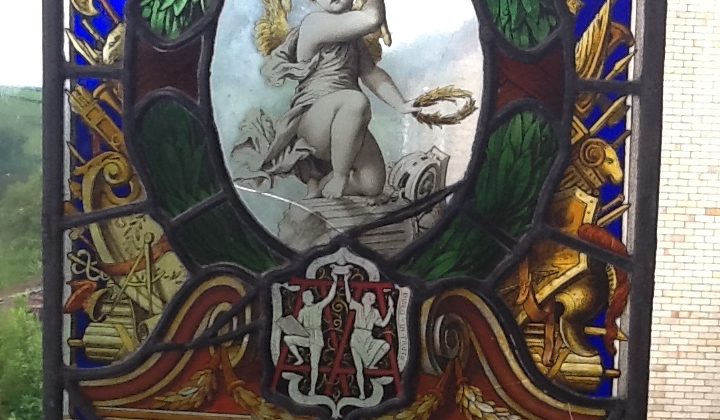The only son of renowned artists Stanhope and Elizabeth Forbes, ‘Alec’ was born in Newlyn on May 26th 1893. Much of his idyllic childhood was spent in the exhilarating company of young artists who shared his love of exploring the wild, rugged natural landscape of West Cornwall.
Having enjoyed an exceptionally enlightened education at Bedales School, he enrolled at The Architectural Association in London. His determination to succeed ensured that he soon became one of their most promising students. In the summer of 1914 he was awarded a Travel Scholarship, ‘But his ambitious plans for touring through Europe were frustrated by the outbreak of war.
Initially deemed unfit for military service, it was only after an operation and several months of recuperation that he was finally able to enter the army in April 1915. His uncle, a director of the London, Brighton and South Coast railway, secured him a commission serving in the Railway Forwarding Office. In May he was posted to Northern France, where his ability to speak fluent French and understanding of railway work enabled him to become a valued and efficient officer. Though initially enthusiastic and immensely proud to be wearing khaki, the sight of and endless stream of wounded soldiers returning to ‘Blighty’, made him feel increasingly uneasy about doing such a ‘safe’ and ‘cushy’ job. He longed for an opportunity to serve in a front line regiment.
Early one morning whilst on leave, he ignored the wishes of his family and travelled to the Headquarters of the D.C.L.I. In Bodmin. There he succeeded in persuading the C.O., Colonel Harvey, to allow him to transfer to the regiment.
After months of trading at Fort Purbrook and a short course at The Clapham Grenade School, he joined D Company, 3rd Battalion D.C.L.I at Freshwater on the Isle of Wight. He finally embarked for France on Wednesday 16th August 1916. Within two weeks he had experienced life in the trenches. He wrote,
“It is priceless to be here and as it’s taken me so long to get here I appreciate it now. By degrees we have got rid of the thick coating of mud which we brought back yesterday. On the whole everyone is fairly well. Our C.O., Colonel Ferguson D.S.O., is such a nice man and makes himself very pleasant to new subalterns. If I become a casualty in the next few days it will be satisfactory to have gone under in one of the really big shows.”
“The rats are awful – but Tommy Atkins ever equal to the occasion fixes a bit of cheese at the end of his bayonet shoves it round the corner and waits. Presently Mr Rat arrives and starts to nibble the tempting morsel when the rude shock of a discharged rifle shakes his poor little body into the middle of next week”.
It was not long before Alec and his men were to see action. The Battalion Diary records,
3rd Sept 1916 Night of the 2/3 rd September the 1st D.C.L.I. Set out on their march to the front line trenches. They were in position by about 4 a.m.
The main operations were due to begin at 12 noon and were to attack Falfemont farm. Until it was attacked we were unable to advance towar ds Combles.
With the exception of shell – fire, which was always more or less heavy as the guns were seldom silent, the early morning of the 3rd was quiet and the weather fine.
The Battalion was to go over in four waves. ‘All ranks were full of confidence and in high spirits’
At zero hour an intense artillery barrage was put down all along the German front and the troops advanced to the assault. So effective had been the fire of our guns that the first and second waves of Cornwalls, following quickly behind the barrage quickly captured the first objective. The third wave reached the line of the sunken road running south from Guillemont and took it; the fourth wave then moved up into the Bodmin Trench. The enemy met the advance with heavy barrage, but the Cornwalls pressed on steadily to their objective, quite undeterred. Even the storm of a machine gun fire brought to bear on them failed to stop them, for the German machine gun teams were soon disposed of by rifle fire which showed the coolness and excellent marksmanship of the D.C.L.I. But it was during the advance to the first objective that most of the casualties to officers and men were sustained. Among them were four gallant young subalterns, all platoon commanders who fell at the head of their men, killed or mortally wounded: they were 2/Lieuts. E.G.T. Kitson, W.A.S.Forbes,J.G. Teague and W.T.Hitchens.
On 8th Sept, Colonel Fargus, Alec’s commanding officer, wrote,
Dear Mr Forbes I deeply regret to have to inform you that your son was killed in act ion on September 3 rd . He was killed at the head of his platoon while leading them to the assault. He had not been with me very long, but I had already formed a most favourable opinion of him and regarded him as one of my most promising officers. He took hi s platoon over in a most gallant way. He is buried close to where he fell not far from and a little to the south of Guillemont. It may help you in your loss – as your boy contributed to it – to know that the regiment did magnificently that day and captured all their objectives. Please accept on behalf of myself and the regiment our deepest sympathy with you and your family.
Yours sincerely Harold Fargus Lt Col Duke of Cornwall’s Light Infantry

